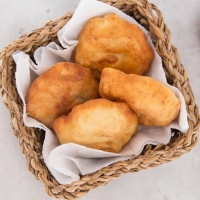Native American Fry Bread
From tuilelaith 4 years agoIngredients
- 3 cups vegetable oil or shortening (enough for 1-inch depth, for frying) shopping list
- 1 cup all-purpose flour, plus more for dusting shopping list
- 1 1/2 teaspoons baking powder shopping list
- 1/4 teaspoon salt shopping list
- 1/2 cup milk shopping list
How to make it
- Gather the ingredients.
- In a deep, 10-inch cast-iron skillet or heavy saucepan, heat about 1 inch of oil to 350 F.
- If you don't have a deep-fry thermometer to attach to the pan, dip the handle end of a wooden spoon in the oil.
- The oil should bubble around it fairly steadily when it's ready.
- The popcorn method is another option:
- Place a kernel of popcorn in the oil, and it will pop when the oil reaches 350 to 360 F.
- Meanwhile, combine the flour, baking powder, and salt in a bowl.
- Mix well to blend.
- Add the milk and stir until the dough holds together.
- Knead 3 or 4 times on a floured surface.
- Divide the dough into 4 uniform pieces and shape each into a ball.
- Using a lightly floured rolling pin, roll each ball of dough into a circle that's about 1/4- to 1/2-inch thick.
- Make a depression in the center of each round of dough (it will puff up while frying).
- Carefully slide 1 or 2 pieces of dough into the hot oil.
- Fry for about 1 to 2 minutes on each side, or until lightly browned.
- Remove the fried dough to paper towels to drain.
- ~ ~ ~ ~ ~
- How to Serve Fry Bread
- Sprinkle the fry bread with a little cinnamon and sugar.
- Dust fry bread with powdered sugar and add a drizzle of honey or syrup.
- Serve the bread as a taco salad base or with taco toppings (popularly called Navajo tacos).
- Be sure to make the circles of dough very thin for this use.
- Cut hot fry bread into wedges and serve with salsa or a dipping sauce.
- ~ ~ ~ ~ ~
- Tips
- Be careful not to knead the dough too much because the bread will be hard and tough.
- The dough is sticky but easy to work with; keep your hands and work surface well-floured.
- Adjust the thickness of the dough for your use. For instance, when making tacos, start with a very thin dough (less than 1/4 inch). Press a deep indentation into the center to prevent it from turning into a ball.
- Use your favorite type of oil for frying. Vegetable oil and shortening are popular options, canola oil is considered a little healthier, and lard is traditionally used by many Native Americans.
- The key to using different oils is to ensure whichever you choose has a high smoke point. Some, such as extra-virgin olive oil, will smoke before it reaches the desired temperature, and the bread will taste burnt, and your kitchen will fill with smoke.
- If using lard to fry the bread, make sure that you use about 2 1/2 cups of lard instead of the 3 cups of vegetable oil.
- If using shortening instead of vegetable oil, you will need about 2 1/4 cups for frying.
- When cooking a larger batch, keep finished fry bread warm in the oven. Set the drained fry bread on a baking sheet fitted with a cooling rack so it doesn't get soggy.
- ~ ~ ~ ~ ~
- What's the Best Way to Store and Reheat Fry Bread?
- Fry bread is best when it's freshly fried. If you need to store leftovers, keep it at room temperature loosely wrapped in plastic or in an unsealed plastic bag for up to 2 days. To reheat it, wrap the bread individually in foil and bake in a 375 F oven for about 10 to 12 minutes.
- ~ ~ ~ ~ ~
- Can Fry Bread Be Frozen?
- Fry bread can be frozen for up to three months. Wipe the oil off with a paper towel once the bread cools and wrap it tightly in plastic, then place it in a freezer bag. For better results, freeze the uncooked dough when it's still in the ball shape using the same type of packaging. Thaw the dough overnight in the refrigerator, unwrap it and let it reach room temperature before shaping and frying as normal.
- ~ ~ ~ ~ ~
- What's the Difference Between Fry Bread and Sopapillas?
- Many cultures throughout the world have a version of fried bread. Native American fry bread and sopapillas are two types that are nearly identical and have similar origins. During the 1860s, the Navajo people and other tribes were resettled onto reservations in eastern New Mexico1. Fry bread made good use of the government rations they relied on, which included flour, sugar, salt, and lard. Around the same time, residents of older New Mexico towns received the same ingredients and they too created a fluffy, crispy fry bread that became known as sopaipilla in Spanish. The Navajo version is round, while sopapillas are typically square. The recipes for each vary greatly, though sopapillas most often use shortening and water rather than fry bread's milk.
People Who Like This Dish 1
- clbacon Birmingham, AL
- tuilelaith Columbia, MO
- Show up here?Review or Bookmark it! ✔
The Groups
- Not added to any groups yet!


Reviews & Comments 1
-
All Comments
-
Your Comments